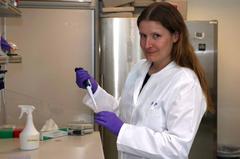URL: https://www.desy.de/news/news_search/index_eng.html
Breadcrumb Navigation
DESY News: Biomolecules under scrutiny
News
News from the DESY research centre
Biomolecules under scrutiny
Charlotte Uetrecht is an expert in viruses, how they assemble and how they replicate. The group leader at the Centre for Structural Systems Biology CSSB and collaborators Erik Marklund from Uppsala University and Carl Caleman from Uppsala University/DESY (CFEL) will now receive funding from the Röntgen-Ångström Cluster (RÅC), a Swedish-German research collaboration, for their Small Angle X-ray Free Electron Laser Scattering (SAXFELS) project. This four-year project, with a combined funding of 1.75 million euros, will develop a new method for examining macromolecular structures by integrating and developing powerful techniques for gas-phase sample manipulation with X-ray diffraction imaging.

CSSB-Forscherin Charlotte Uetrecht. Bild: HPI, Franziska Ahnert
SAXFELS will adapt the prototype delivery system developed by the Horizon 2020 project MS SPIDOC, which is also coordinated by Charlotte Uetrecht. The existing delivery system, which transports subpopulations of a protein solution to the European XFEL’s SPB beamline, will be altered to accommodate gas phase SAXS at the European XFEL’s Soft-X-ray Port (SXP), a beamline where users are able to set up their own experiment stations. The new technique will be tested on various coronavirus proteins including SARS-CoV-2 nsp complexes.
“An oriented gas-phase SAXS for X-ray free-electron lasers has not been developed anywhere else in the world and will make the SXP beamline unique,” explains Uetrecht “We will merge state-of-the-art MS techniques with diffractive imaging techniques at the European XFEL, to make a large technology leap for SAXS.” She also notes that the SAXFELS is a technique that the scientific community will be able to use at other X-ray facilities such as DESY’s PETRA III beamlines or Lund University’s MAX IV.
“Since its inception, CSSB has been collaborating with colleagues from Sweden with the help of RÅC funding,” notes Kay Gruenewald, CSSB’s scientific director. “SAXFELS is an exciting new project and I am looking forward to seeing it develop.”



